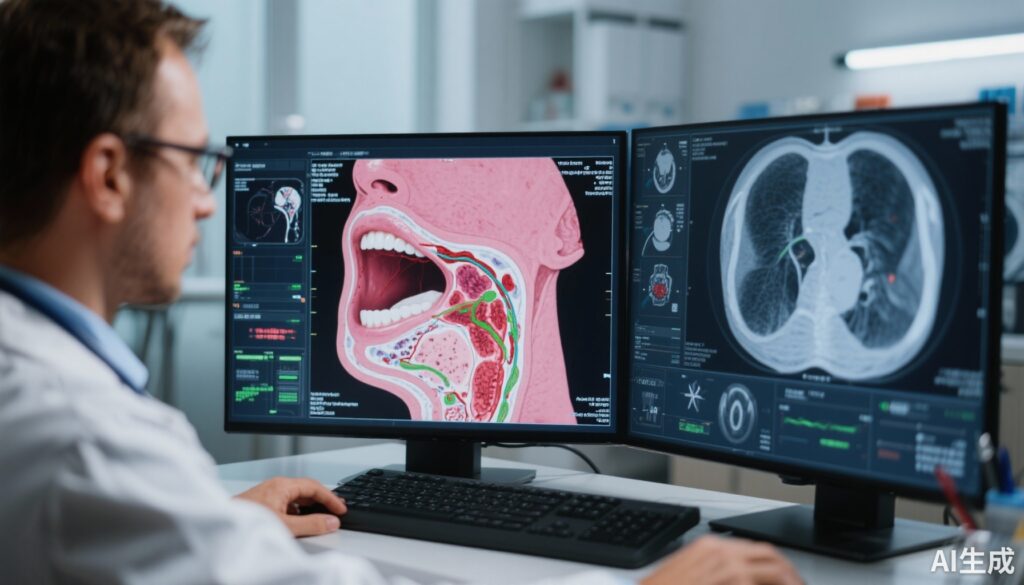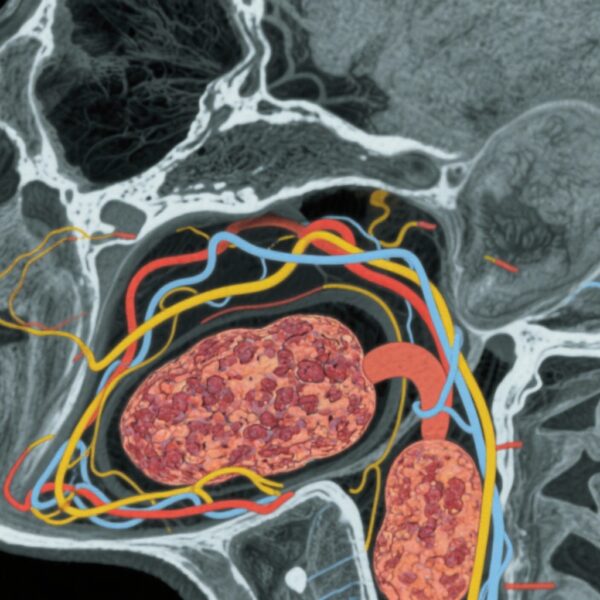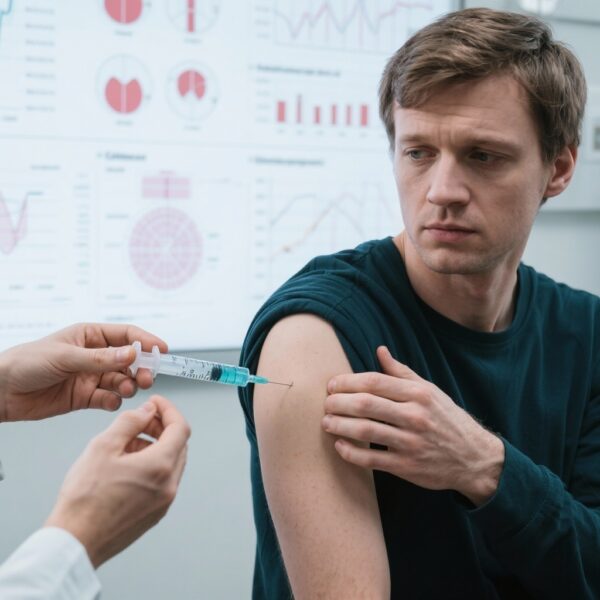Highlight
This large-scale international study assessed the accuracy and prognostic significance of radiologic extranodal extension (iENE) in HPV-mediated oropharyngeal cancer (HPV+ OPC). Key findings include:
- iENE demonstrated modest sensitivity (44.5%) but high specificity (87.6%) with substantial intercenter variability.
- Combining CT and MRI imaging significantly improved diagnostic accuracy, enhancing sensitivity to 84.6% and specificity to 94.5%.
- Specialist head and neck radiologists yielded better specificity compared to nonspecialists.
- iENE positivity was not an independent predictor of overall or disease-free survival in multivariable analyses.
- Current TNM staging modifications incorporating iENE showed limited improvement in prognostic power.
These results underscore the need for validated consensus criteria and optimized imaging protocols to better inform treatment decisions in HPV+ OPC.
Study Background
Human papillomavirus-mediated oropharyngeal squamous cell carcinoma (HPV+ OPC) represents a distinct clinical entity with generally favorable outcomes compared to HPV-negative disease. Accurate staging critically guides therapeutic strategies, in which extranodal extension (ENE)—the microscopic or gross spread of tumor beyond nodal capsule—is an established adverse prognostic factor. Radiologic detection of ENE (iENE) from cross-sectional imaging such as computed tomography (CT) or magnetic resonance imaging (MRI) is widely used in clinical practice to stratify patients and select treatment modalities including surgery and chemoradiation therapy (CRT).
However, prior single-center studies have reported widely varying sensitivity and specificity of iENE detection, with inconsistent interobserver agreement. Moreover, whether iENE independently predicts survival outcomes in HPV+ OPC remains controversial. Given the increasing incidence of HPV+ OPC globally and its unique radiologic and clinical characteristics, robust real-world evidence assessing iENE’s diagnostic performance and prognostic value is essential. This study by the Head and Neck Cancer International Group (HNCIG) sought to address these gaps using a large multinational retrospective cohort.
Study Design and Methods
The study retrospectively analyzed 821 consecutive patients with p16-positive OPC—an established surrogate for HPV-mediated disease—treated between 1999 and 2020 across 13 secondary hospitals in 9 countries. Inclusion criteria comprised treatment with surgery and/or chemoradiation therapy. Radiologic images were evaluated for ENE by blinded reviewers unaware of clinical outcomes to determine iENE status. Histopathologic examination of surgical specimens provided the gold standard reference for ENE (pENE).
The main endpoints were the diagnostic accuracy metrics of iENE including sensitivity, specificity, and negative predictive value, alongside survival outcomes such as overall survival (OS) and disease-free survival (DFS). Additional subgroup analyses assessed the impact of imaging modalities (CT alone, MRI alone, or combined CT+MRI), and reader expertise (specialist vs nonspecialist radiologists). Multivariable Cox regression models analyzed iENE as an independent prognostic factor adjusting for confounders. Lastly, the study evaluated proposed TNM staging modifications incorporating iENE status.
Key Findings
Out of 821 patients, 638 had sufficient data for inclusion in final analyses. Among those with no radiologic ENE (iENE-negative, n=394), 109 (27.7%) were found to have pathologic ENE (pENE) on histology, indicating false negatives. Conversely, 109 of 192 (56.8%) patients with histologically confirmed ENE were not identified by imaging (false negatives), yielding an overall iENE sensitivity of 44.5% (95% CI, 37.8%-51.4%). Specificity was substantially higher at 87.6% (95% CI, 84.1%-90.6%), with a negative predictive value of 75.3% (95% CI, 72.3%-77.5%).
Diagnostic accuracy varied significantly among the centers, reflecting variability in imaging protocols and expertise. Notably, combined CT and MRI imaging markedly improved sensitivity to 84.6% (95% CI, 65.1%-95.6%, P<.001) and specificity to 94.5% (95% CI, 82.3%-99.4%, P=0.022) compared to either modality alone.
Specialist head and neck radiologists achieved significantly higher specificity (89.14%; 95% CI, 85.69%-91.99%) relative to nonspecialists (46.67%; 95% CI, 21.27%-73.41%, P<.001), while sensitivity was similar.
Survival analysis revealed that iENE positivity correlated with worse OS and DFS in unadjusted models; however, in multivariable analysis controlling for known prognostic factors, iENE was not an independent predictor of OS (adjusted hazard ratio [aHR], 1.50; 95% CI, 0.97-2.32; P=0.071) or DFS (aHR, 1.41; 95% CI, 0.95-2.09; P=0.089).
Two modifications to the TNM staging system incorporating iENE status were tested but did not improve prognostic discrimination meaningfully, suggesting limited additive value of current radiologic ENE assessment in staging HPV+ OPC.
Expert Commentary
The study robustly highlights the challenges in accurate radiologic assessment of ENE in HPV+ OPC under routine clinical conditions. The modest sensitivity indicates substantial underdetection of ENE by imaging alone, which may impact treatment decisions if relied upon without histopathological confirmation. The superior accuracy using combined CT and MRI supports guidelines recommending multimodal imaging in suspected advanced nodal disease.
The improved specificity among specialist radiologists further emphasizes the importance of expertise and standardized training to optimize diagnostic reliability. The wide interinstitutional variability observed may also reflect heterogeneous imaging protocols, scanner quality, and interpretative criteria, underscoring the urgent need for internationally accepted standardized diagnostic protocols and validated criteria for iENE assessment.
Importantly, the lack of independent prognostic significance of iENE challenges the current paradigm of heavily weighting radiologic ENE status in treatment eligibility and staging, especially in the HPV+ subset with generally favorable prognosis. These findings align with recent reports suggesting HPV+ OPC’s distinct biology reduces the negative impact of ENE seen in HPV-negative tumors.
Future research should focus on refining imaging biomarkers, incorporating advanced imaging techniques such as diffusion-weighted MRI or PET/MRI, and correlating radiologic findings with molecular and histologic data to better risk stratify HPV+ OPC patients.
Conclusion
This extensive real-world multinational study reveals that radiologic extranodal extension (iENE) in HPV-mediated oropharyngeal cancer demonstrates limited and variable diagnostic accuracy and does not independently predict survival outcomes. Combining CT and MRI modalities and involving specialist radiologists enhance diagnostic performance but are still insufficient for consistent prognostication. These results call for standardized consensus diagnostic criteria and imaging protocols to optimize clinical utility. Until such advances, clinicians should exercise caution in using iENE alone to guide treatment decisions.
Funding and ClinicalTrials.gov
The study was coordinated by the Head and Neck Cancer International Group (HNCIG). Specific funding sources were not detailed in the referenced publication. This retrospective cohort study was not registered on ClinicalTrials.gov.
References
Mehanna H, Abou-Foul AK, Henson C, Kristunas C, Nankivell PC, McDowell L, Leemans CR, van den Brekel MWM, von Buchwald C, Jakobsen KK, Grønhøj C, Rasmussen JH, Lydiatt WM, Gupta V, Branstetter BF, Klussmann JP, Wollenberg B, Schmidl B, Broglie MA, Hendrickx JJ, Awad DR, Prestwich R, Gaultier AL, Oliva M, Nair S, Noor A, Krishnan S, Iyizoba-Ebozue Z, Sethi M, Nauta IH, Zhao D, Yom SS. Accuracy and Prognosis of Extranodal Extension on Radiologic Imaging in Human Papillomavirus-Mediated Oropharyngeal Cancer: A Head and Neck Cancer International Group (HNCIG) Real-world Study. Int J Radiat Oncol Biol Phys. 2025 Oct 1;123(2):432-441. doi: 10.1016/j.ijrobp.2025.04.003. Epub 2025 Apr 24. PMID: 40286939.


